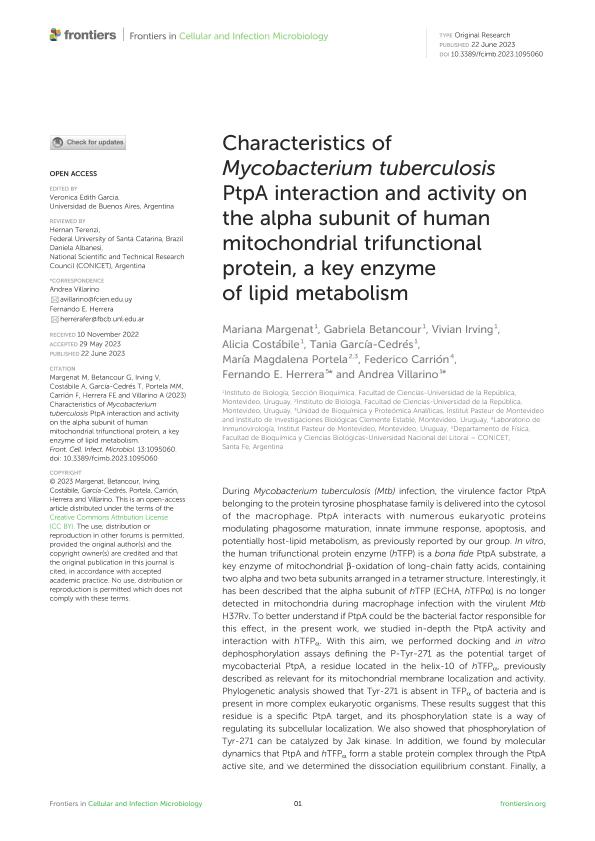Mostrar el registro sencillo del ítem
dc.contributor.author
Margenat, Mariana
dc.contributor.author
Betancour, Gabriela
dc.contributor.author
Irving, Vivian
dc.contributor.author
Costábile, Alicia
dc.contributor.author
García Cedrés, Tania
dc.contributor.author
Portela, María Magdalena
dc.contributor.author
Carrión, Federico
dc.contributor.author
Herrera, Fernando Enrique

dc.contributor.author
Villarino, Andrea
dc.date.available
2024-01-30T10:54:20Z
dc.date.issued
2023-06
dc.identifier.citation
Margenat, Mariana; Betancour, Gabriela; Irving, Vivian; Costábile, Alicia; García Cedrés, Tania; et al.; Characteristics of Mycobacterium tuberculosis PtpA interaction and activity on the alpha subunit of human mitochondrial trifunctional protein, a key enzyme of lipid metabolism; Frontiers Media; Frontiers in Cellular and Infection Microbiology; 13; 6-2023; 1-16
dc.identifier.issn
2235-2988
dc.identifier.uri
http://hdl.handle.net/11336/225141
dc.description.abstract
During Mycobacterium tuberculosis (Mtb) infection, the virulence factor PtpA belonging to the protein tyrosine phosphatase family is delivered into the cytosol of the macrophage. PtpA interacts with numerous eukaryotic proteins modulating phagosome maturation, innate immune response, apoptosis, and potentially host-lipid metabolism, as previously reported by our group. In vitro, the human trifunctional protein enzyme (hTFP) is a bona fide PtpA substrate, a key enzyme of mitochondrial β-oxidation of long-chain fatty acids, containing two alpha and two beta subunits arranged in a tetramer structure. Interestingly, it has been described that the alpha subunit of hTFP (ECHA, hTFPα) is no longer detected in mitochondria during macrophage infection with the virulent Mtb H37Rv. To better understand if PtpA could be the bacterial factor responsible for this effect, in the present work, we studied in-depth the PtpA activity and interaction with hTFPα. With this aim, we performed docking and in vitro dephosphorylation assays defining the P-Tyr-271 as the potential target of mycobacterial PtpA, a residue located in the helix-10 of hTFPα, previously described as relevant for its mitochondrial membrane localization and activity. Phylogenetic analysis showed that Tyr-271 is absent in TFPα of bacteria and is present in more complex eukaryotic organisms. These results suggest that this residue is a specific PtpA target, and its phosphorylation state is a way of regulating its subcellular localization. We also showed that phosphorylation of Tyr-271 can be catalyzed by Jak kinase. In addition, we found by molecular dynamics that PtpA and hTFPα form a stable protein complex through the PtpA active site, and we determined the dissociation equilibrium constant. Finally, a detailed study of PtpA interaction with ubiquitin, a reported PtpA activator, showed that additional factors are required to explain a ubiquitin-mediated activation of PtpA. Altogether, our results provide further evidence supporting that PtpA could be the bacterial factor that dephosphorylates hTFPα during infection, potentially affecting its mitochondrial localization or β-oxidation activity.
dc.format
application/pdf
dc.language.iso
eng
dc.publisher
Frontiers Media

dc.rights
info:eu-repo/semantics/openAccess
dc.rights.uri
https://creativecommons.org/licenses/by-nc-sa/2.5/ar/
dc.subject
ECHA
dc.subject
HUMAN MITOCHONDRIAL TRIFUNCTIONAL PROTEIN
dc.subject
JAK
dc.subject
LIPID METABOLISM
dc.subject
MYCOBACTERIUM TUBERCULOSIS
dc.subject
PTPA
dc.subject
TFP
dc.subject
TYROSINE PHOSPHATASE
dc.subject.classification
Biología Celular, Microbiología

dc.subject.classification
Ciencias Biológicas

dc.subject.classification
CIENCIAS NATURALES Y EXACTAS

dc.title
Characteristics of Mycobacterium tuberculosis PtpA interaction and activity on the alpha subunit of human mitochondrial trifunctional protein, a key enzyme of lipid metabolism
dc.type
info:eu-repo/semantics/article
dc.type
info:ar-repo/semantics/artículo
dc.type
info:eu-repo/semantics/publishedVersion
dc.date.updated
2024-01-26T11:10:26Z
dc.journal.volume
13
dc.journal.pagination
1-16
dc.journal.pais
Suiza
dc.journal.ciudad
Lausanne
dc.description.fil
Fil: Margenat, Mariana. Universidad de la República. Facultad de Ciencias; Uruguay
dc.description.fil
Fil: Betancour, Gabriela. Universidad de la República. Facultad de Ciencias; Uruguay
dc.description.fil
Fil: Irving, Vivian. Universidad de la República. Facultad de Ciencias; Uruguay
dc.description.fil
Fil: Costábile, Alicia. Universidad de la República. Facultad de Ciencias; Uruguay
dc.description.fil
Fil: García Cedrés, Tania. Universidad de la República. Facultad de Ciencias; Uruguay
dc.description.fil
Fil: Portela, María Magdalena. Universidad de la República. Facultad de Ciencias; Uruguay
dc.description.fil
Fil: Carrión, Federico. Instituto Pasteur de Montevideo; Uruguay
dc.description.fil
Fil: Herrera, Fernando Enrique. Universidad Nacional del Litoral. Facultad de Bioquímica y Ciencias Biológicas; Argentina. Consejo Nacional de Investigaciones Científicas y Técnicas. Centro Científico Tecnológico Conicet - Santa Fe; Argentina
dc.description.fil
Fil: Villarino, Andrea. Universidad de la Republica; Uruguay
dc.journal.title
Frontiers in Cellular and Infection Microbiology
dc.relation.alternativeid
info:eu-repo/semantics/altIdentifier/url/https://www.frontiersin.org/articles/10.3389/fcimb.2023.1095060/full
dc.relation.alternativeid
info:eu-repo/semantics/altIdentifier/doi/http://dx.doi.org/10.3389/fcimb.2023.1095060
Archivos asociados
